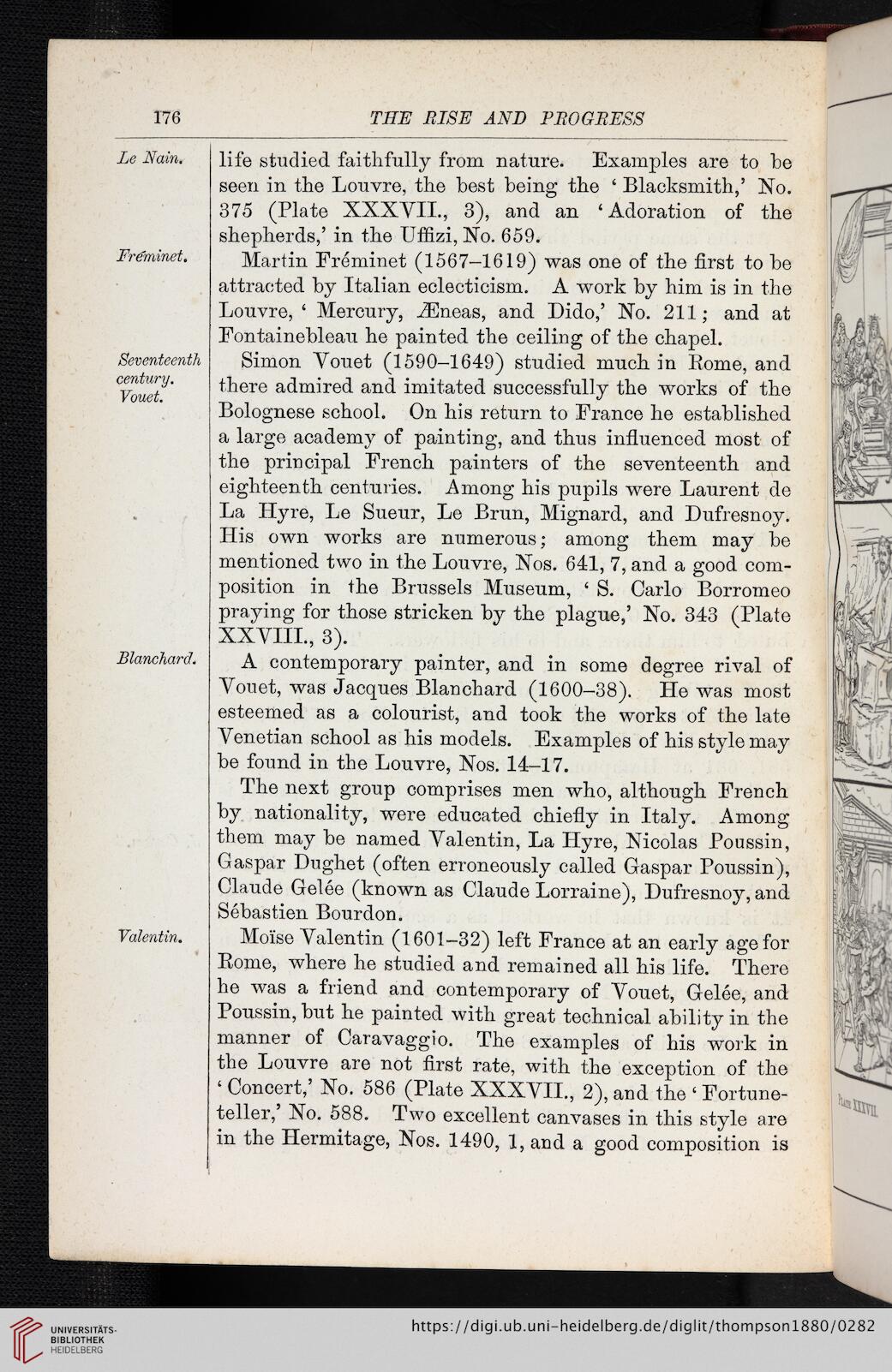176
THE RISE AND PROGRESS
Le Nain.
Freminet.
Seventeenth
century.
Vouet.
Blanchard.
Valentin.
life studied faithfully from nature. Examples are to be
seen in the Louvre, the best being the ' Blacksmith,' No.
375 (Plate XXXVII., 3), and an 'Adoration of the
shepherds,' in the Uffizi, No. 659.
Martin Freminet (1567-1619) was one of the first to be
attracted by Italian eclecticism. A work by him is in the
Louvre, ' Mercury, Tineas, and Dido,' No. 211; and at
Fontainebleau he painted the ceiling of the chapel.
Simon Vouet (1590-1649) studied much in Rome, and
there admired and imitated successfully the works of the
Bolognese school. On his return to France he established
a large academy of painting, and thus influenced most of
the principal French painters of the seventeenth and
eighteenth centuries. Among his pupils were Laurent de
La Hyre, Le Sueur, Le Brun, Mignard, and Dufresnoy.
His own works are numerous; among them may be
mentioned two in the Louvre, Nos. 641, 7, and a good com-
position in the Brussels Museum, ' S. Carlo Borromeo
praying for those stricken by the plague,' No. 343 (Plate
XXVIII., 3).
A contemporary painter, and in some degree rival of
Vouet, was Jacques Blanchard (1600-38). He was most
esteemed as a colourist, and took the works of the late
Venetian school as his models. Examples of his style may
be found in the Louvre, Nos. 14-17.
The next group comprises men who, although French
by nationality, were educated chiefly in Italy. Among
them may be named Valentin, La Hyre, Nicolas Poussin,
Gaspar Dughet (often erroneously called Gaspar Poussin),
Claude Gelee (known as Claude Lorraine), Dufresnoy, and
Sebastien Bourdon.
Moi'se Valentin (1601-32) left France at an early age for
Rome, where he studied and remained all his life. There
he was a friend and contemporary of Vouet, Gelee, and
Poussin, but he painted with great technical ability in the
manner of Caravaggio. The examples of his work in
the Louvre are not first rate, with the exception of the
' Concert,' No. 586 (Plate XXXVII., 2), and the ' Fortune-
teller,' No. 588. Two excellent canvases in this style are
in the Hermitage, Nos. 1490, 1, and a good composition is
THE RISE AND PROGRESS
Le Nain.
Freminet.
Seventeenth
century.
Vouet.
Blanchard.
Valentin.
life studied faithfully from nature. Examples are to be
seen in the Louvre, the best being the ' Blacksmith,' No.
375 (Plate XXXVII., 3), and an 'Adoration of the
shepherds,' in the Uffizi, No. 659.
Martin Freminet (1567-1619) was one of the first to be
attracted by Italian eclecticism. A work by him is in the
Louvre, ' Mercury, Tineas, and Dido,' No. 211; and at
Fontainebleau he painted the ceiling of the chapel.
Simon Vouet (1590-1649) studied much in Rome, and
there admired and imitated successfully the works of the
Bolognese school. On his return to France he established
a large academy of painting, and thus influenced most of
the principal French painters of the seventeenth and
eighteenth centuries. Among his pupils were Laurent de
La Hyre, Le Sueur, Le Brun, Mignard, and Dufresnoy.
His own works are numerous; among them may be
mentioned two in the Louvre, Nos. 641, 7, and a good com-
position in the Brussels Museum, ' S. Carlo Borromeo
praying for those stricken by the plague,' No. 343 (Plate
XXVIII., 3).
A contemporary painter, and in some degree rival of
Vouet, was Jacques Blanchard (1600-38). He was most
esteemed as a colourist, and took the works of the late
Venetian school as his models. Examples of his style may
be found in the Louvre, Nos. 14-17.
The next group comprises men who, although French
by nationality, were educated chiefly in Italy. Among
them may be named Valentin, La Hyre, Nicolas Poussin,
Gaspar Dughet (often erroneously called Gaspar Poussin),
Claude Gelee (known as Claude Lorraine), Dufresnoy, and
Sebastien Bourdon.
Moi'se Valentin (1601-32) left France at an early age for
Rome, where he studied and remained all his life. There
he was a friend and contemporary of Vouet, Gelee, and
Poussin, but he painted with great technical ability in the
manner of Caravaggio. The examples of his work in
the Louvre are not first rate, with the exception of the
' Concert,' No. 586 (Plate XXXVII., 2), and the ' Fortune-
teller,' No. 588. Two excellent canvases in this style are
in the Hermitage, Nos. 1490, 1, and a good composition is




